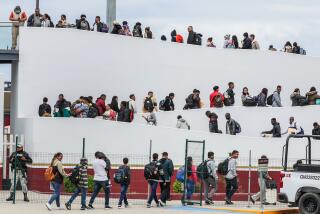Whistle Blows for History on Ancient Train
Railway carriages that escaped Lawrence of Arabia’s desert raids in World War I are again clattering along the old Hejaz railway, built by the Ottomans’ last caliph to carry pilgrims to Mecca.
The peeling wood and rattling windows of the 80-year-old carriages testify to the history of the line and to the regional turmoil that has kept modernization at bay.
Jordan and Syria resumed a weekly service on the 138-mile stretch between Amman and Damascus in October after an eight-year interruption.
The engines are modern diesels. But the Belgian-built carriages and most of the track are the ones that were used when the line was built.
They are some of the oldest still in use for a regular passenger service, rather than as a tourist attraction.
“There’s no other one like it,” said Friedrich Pichler, a widely traveled Austrian railroad consultant who made the eight-hour trip to Damascus just to ride the train. “When you travel on this railroad, it’s like people felt in the ‘20s.”
The fare, too, can prompt nostalgia: about $3.50 for first class and $2.10 for second class.
The Turkish Sultan Abdel-Hamid conceived the line to ferry Muslim pilgrims on the annual hajj , or pilgrimage to Mecca, birthplace of the Prophet Mohammed, as well as to cement his rule over the Ottoman Empire’s restive Arab provinces.
Construction on the German-engineered line started in 1900 in Damascus. It ended in Medina, in what is now Saudi Arabia, eight years and 810 miles later.
The Turks matched a unique 105-centimeter, narrow gauge used accidentally on an earlier French line from Beirut to Damascus.
“It should have been 1,065 millimeters, but someone cut the track supports to the wrong width and for reasons of saving money it was decided to build the line to fit them instead of sending for new ones,” says Geoffrey Freeman Allen, editor of Jane’s World Railways in London.
Turmoil in Turkey and the outbreak of World War I ended plans to extend the line to Mecca.
And marauding Arab rebels accompanied by the British officer T. E. Lawrence, the legendary “Lawrence of Arabia,” repeatedly raided the line during the war to block Turkish supplies.
British Maj. Sir Hubert Young, who accompanied Lawrence, later wrote: “Nothing seemed to give him greater pleasure than to squat down less than 200 yards from the railway line . . . and watch with complete unconcern the slow approach of a train full of Turkish soldiers.
“As soon as the engine was over the undiscovered mine, he would jam down the knob of the exploder, retire to his waiting camel and ride away, hotly pursued by the fire of any soldiers who might have escaped from the rear carriages.”
Damaged bridges and wrecked trains derailed by Lawrence, remarkably preserved in the dry desert air, can still be found along the old line, mainly in southern Jordan and Saudi Arabia, where passenger service on the Hejaz stopped years ago.
The track that once carried pious pilgrims now ferries phosphate on rebuilt lines through southern Jordan to the port of Aqaba.
The original track north of Amman forces engineers to hold speeds to 31 m.p.h. on straight stretches and 21 1/2 m.p.h. on curves as the train traces the edge of the vast Arabian desert.
It rattles through empty vistas of arid land, past encampments of goat-hair Bedouin tents fragrant with brushwood smoke from fires for brewing tea, past ruined Ottoman watering stations built of stone.
In towns, the rare passage of a train briefly halts normal life. Men and women wave from balconies. Soccer players interrupt their games. Mobs of shrieking children dance and race the horn-blaring train--and sometimes even throw stones at it.
The trip is still a novelty as well to the unusually friendly customs and immigration officials.
At the Syrian entry station of Deraa, no bankers awaited foreigners for the mandatory exchange of currency. So cheerful police packed the only two Westerners into the back of a jeep and raced them 3 1/2 miles to an exchange post. The officers had to push-start their vehicle on the return leg.
The future of the eccentric service is in doubt, however: History is at war with economics.
Railroad officials say it would be too expensive to renovate the weather-beaten wooden cars, whose squeaking wall panels sometimes wiggle independently of their neighbors.
The odd, small size of the track also makes it impossible to carry much freight or trains from standard-gauge tracks used elsewhere.
Marwan Hadawi, general director of Syria’s branch of the railroad, says Damascus is already preparing the roadbed for a new standard-gauge track to the Jordanian border.
The Syrians also are considering using more modern Hungarian passenger cars to replace the ancient Belgian cars on the run to Amman. The Hungarian cars already serve Damascus and Deraa daily.
A 1981 study by German consultants proposed replacing the whole system with a modern, standard-gauge line. But the $3-billion to $4-billion price tag means that project is at best far in the future.
More to Read
Start your day right
Sign up for Essential California for news, features and recommendations from the L.A. Times and beyond in your inbox six days a week.
You may occasionally receive promotional content from the Los Angeles Times.






